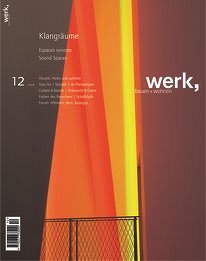Editorial
Like the experience of space, memory is also made up of both images and sounds. Architects are familiar with the image: it is omnipresent and is seen as the measure of what has been built. Sound, however, is often only thought of later. In the opening essay to this issue Pierre Mariétan urges that hearing should more often become listening and that we should train our hearing in order to refine both our perception of the sounds we hear in everyday life and also our „inner ear“. And regarding this inner ear Glenn Gould once described an incident from his youth: he was playing Mozart when suddenly a vacuum cleaner was switched on beside his instrument. This placed such an extreme demand on the young piano player's ability to imagine sound that he later recreated the situation whenever he had to learn a new score. Having even a fraction of this power of imagination would be desirable for architects when designing space: as a result spaces might no longer freeze as perspective images but could begin to vibrate with possible sounds. In his essay on the relationship between seeing and hearing in the history of the concert hall Jürg Jecklin uses a number of different examples from the 18th and 19th centuries and comes to an interesting conclusion. The article about acoustic pots in the mediaeval churches takes a look further back into the past. And a contribution about the different colours of noise listens to contemporary background sounds. It is difficult to approach the sounds of a building through reading or writing, but the five buildings we present in this issue have made the task somewhat easier for us. They provide spaces for rock music and classical concerts, in larger and smaller settings, for theatre performances and also for speech training and therapy. Depending on its place and function each of these building makes a different gesture to the outside. The sounds, words and music in the interior remain inscribed in the architecture as a memory, even after they have faded away. We hope that the texts and the images will awaken readers' curiosity about their sonic potential. The Philharmonics in Luxembourg resembles an almond raised on a platform that suggests an internal life through its veil of columns. In the music room in Gaasbeek the structure of the bricks links inside and outside and allows sounds to move freely in space. The concert and performance centre in Matsumoto interprets the form of the site as a guitar. The Lausanne University Hospital pavilion for phoniatrics and speech therapy is made up of a transparent shell around the concrete core, thus reversing the normal order of hard and soft, while the Kofmehl culture factory in Solothurn is a rusty block with a vital internal life. These buildings were all differently planned and constructed and so they all sound different – or: they each sound different because each of them was designed according to an individual idea. The editors
